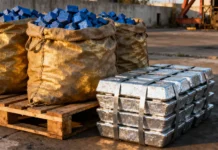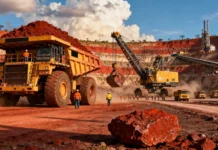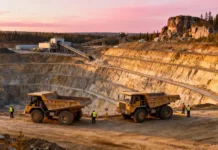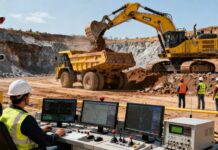Hydrogen Powering the Next Generation of Mine Energy Systems
Hydrogen stands poised to fundamentally reshape mining’s energy landscape. As mining operations worldwide confront regulatory requirements to reduce greenhouse gas emissions, hydrogen emerges as one of the most versatile decarbonization technologies applicable across mining’s diverse energy demands. From powering heavy equipment fleets to decarbonizing energy-intensive smelting operations, hydrogen technology offers pathways enabling mining companies to dramatically reduce emissions while maintaining operational capabilities essential for production.
Yet hydrogen in mining represents more than theoretical promise. Early-stage commercial deployments already demonstrate feasibility and reveal both transformative potential and practical implementation challenges. For mining companies making strategic energy decisions today, hydrogen deserves serious consideration as key component of comprehensive clean mining strategies.
Understanding Hydrogen’s Role in Mining Energy Systems
Hydrogen functions uniquely in mining applications because it addresses diverse energy requirements through a single versatile carrier. Mining operations require continuous electricity for processing facilities, high-temperature heat for smelting operations, and powerful portable power for mobile equipment. Traditional approaches employ different energy sources for each application—grid electricity or renewables for stationary processing, fossil fuels for heating, diesel fuel for equipment. Hydrogen’s versatility enables potentially consolidating multiple energy needs onto unified hydrogen infrastructure.
Hydrogen produces water as its only combustion byproduct, enabling zero-emission operation when used in fuel cells or direct combustion applications. Unlike electrification—suitable for stationary equipment but impractical for certain mobile applications—hydrogen maintains continuous operation capabilities without battery range limitations. For mining’s 24/7 operational demands, this continuous capability proves operationally essential.
Hydrogen in Fleet Electrification and Equipment Powering
Mining fleets encompassing thousands of vehicles—haul trucks, loaders, drill rigs, and support equipment—consume enormous quantities of diesel fuel. Transitioning these fleets to renewable energy represents a central challenge in mining’s decarbonization efforts. Battery electric vehicles suit some applications but face limitations for heavy equipment operating continuously in remote locations where charging infrastructure proves impractical.
Hydrogen fuel cells address these limitations by providing continuous operation, rapid refueling (10-15 minutes), and sufficient energy density for demanding applications. Several mining companies have begun pilot programs deploying hydrogen fuel cell haul trucks and other equipment. Early operational data demonstrates fuel cell vehicles performing comparably to diesel equivalents while eliminating direct operational emissions.
The infrastructure requirements prove more demanding than battery electrification alone. Hydrogen fuel cell vehicles require hydrogen generation and storage facilities plus refueling infrastructure at mine sites. Compared to traditional diesel fueling or battery charging, hydrogen refueling demands more sophisticated logistics and safety management. However, for mining operations sufficiently large to justify infrastructure investment, hydrogen fueling costs increasingly prove competitive with diesel when accounting for hydrogen production from renewable electricity.
Decarbonizing High-Temperature Processing Operations
Mining’s most intractable decarbonization challenge involves high-temperature processes requiring sustained intense heat. Copper smelting, nickel processing, and gold refining typically demand temperatures exceeding 1,000 degrees Celsius. Traditional fossil fuel combustion provides this heat cost-effectively, but replaces no feasible low-carbon alternative at scale.
Hydrogen offers potential solution. Direct hydrogen combustion generates temperatures suitable for smelting applications while producing only water vapor as byproduct. More sophisticated approaches employ hydrogen reduction processes, where hydrogen directly reduces metal oxides to pure metals, eliminating carbon dioxide generation entirely. Emerging hydrogen-based smelting pilot projects demonstrate technical feasibility of these approaches.
Hydrogen in energy-intensive refining processes represents particularly promising application because refining already demands high temperatures and sustained operations unsuitable for intermittent renewable energy. Hydrogen, storable and deployable as needed, solves the intermittency challenges that render renewable electricity inadequate for certain high-temperature processes. Mining companies can generate hydrogen during periods of peak renewable energy availability and store it for deployment during refining operations regardless of renewable availability.
Hydrogen Production From Renewable Electricity
Realizing hydrogen’s potential in mining fundamentally depends on producing hydrogen from renewable electricity rather than fossil fuels. Electrolysis—splitting water using electrical current—generates hydrogen from renewable energy sources. Green hydrogen produced from renewable electricity represents the most promising pathway for mining applications because it delivers hydrogen with genuinely low carbon footprint.
Current electrolyzer technology operates efficiently and continues improving. Emerging solid oxide electrolyzers promise even higher efficiency, potentially reaching 85-90 percent electrical-to-hydrogen energy conversion efficiency. Decreasing costs, driven by manufacturing scale-up, make hydrogen production from renewable electricity increasingly economically competitive with fossil fuel alternatives.
For mining operations increasingly adopting on-site renewable generation—solar and wind installations—dedicated electrolyzers represent natural integration. Rather than selling excess renewable electricity to grids or curtailing generation when demand drops, mining operations can convert excess renewable capacity into hydrogen storage. This hydrogen then powers equipment and processes regardless of renewable generation timing, solving intermittency challenges inherent in renewable energy systems.
Economic Feasibility and Emerging Business Models
Hydrogen in mining remains expensive compared to traditional energy sources in most current applications. However, the economic trajectory proves favorable. Renewable electricity costs continue declining—currently cheaper than fossil fuel equivalents in many regions and increasingly cheaper worldwide. Electrolyzer costs similarly decline as manufacturing scales. Hydrogen infrastructure and equipment costs, while currently high, will decline as mining and other industries adopt hydrogen technologies.
Several business models support hydrogen adoption in mining. Some mining companies are investing directly in hydrogen infrastructure, viewing these investments as component of capital-intensive mining operations. Others partner with hydrogen producers who establish infrastructure at mine sites and supply hydrogen to mining operations. Still others combine approaches, establishing local renewable electricity generation and hydrogen production while maintaining flexibility to purchase hydrogen from external suppliers during periods of insufficient local generation.
Forward-thinking mining companies increasingly recognize that evaluating hydrogen economics requires long-term perspective. Projects deployed today may generate negative returns compared to fossil fuel alternatives, but investment decisions should account for regulatory evolution requiring emissions reductions, investor and customer preferences favoring decarbonization, and favorable long-term hydrogen cost trajectories.
Infrastructure Development and Technical Challenges
Deploying hydrogen in mining operations at scale requires developing supporting infrastructure and solving numerous technical challenges. Hydrogen storage requires specialized equipment—high-pressure tanks, cryogenic systems, or chemical storage media. Hydrogen refueling infrastructure for vehicle fleets demands safety protocols and specialized engineering. Integration with existing mining processes requires careful engineering and operational modifications.
Technical challenges facing deployment include hydrogen embrittlement issues in certain metals requiring specialized materials, ensuring safety in mining environments where methane or other explosive atmospheres might exist, and maintaining hydrogen quality standards necessary for fuel cell operation. None of these challenges appear insurmountable, but implementation demands careful engineering and substantial technical expertise.
Geography influences hydrogen feasibility significantly. Mining operations in regions with abundant renewable energy resources and established hydrogen industry infrastructure face substantially lower costs than operations in remote locations requiring infrastructure development from scratch. This geographic variability suggests hydrogen adoption patterns will diverge, with leading adoption occurring in mining clusters benefiting from existing hydrogen infrastructure or exceptional renewable energy resources.
Policy and Regulatory Drivers
Hydrogen adoption in mining increasingly follows from policy frameworks supporting clean mining transitions. Several governments offer tax incentives or subsidies for hydrogen equipment purchases or renewable hydrogen production. Regulatory requirements mandating emissions reductions create business drivers for deploying available decarbonization technologies. Carbon pricing schemes, where carbon emissions face economic penalties, directly improve hydrogen economics by making fossil fuel alternatives more expensive.
This regulatory environment proves critical for hydrogen deployment because costs currently exceed fossil fuel alternatives. Without policy support improving hydrogen’s competitive position, adoption would slow to research pilots rather than commercial deployment. However, as regulatory frameworks increasingly support emissions reductions, hydrogen infrastructure investment becomes commercially attractive even before technological cost reductions mature.
Hydrogen in Comprehensive Clean Mining Energy Systems
Hydrogen functions most effectively within comprehensive mining energy strategies rather than as standalone solution. Leading mining companies pursuing emissions reductions employ portfolios of clean energy technologies—renewable electricity directly powering stationary processes, hydrogen powering mobile equipment and high-temperature operations, energy efficiency improvements reducing total energy demands, and where necessary, carbon offsets addressing residual emissions.
This integrated approach recognizes that hydrogen, while powerful, cannot economically decarbonize all mining operations in isolation. Renewable electricity proves more cost-effective for many stationary applications; hydrogen excels for mobile and high-temperature applications. Similarly, efficiency improvements and waste heat recovery reduce overall energy demands, making subsequent transitions to clean energy sources more feasible.
The Trajectory Forward: Hydrogen’s Expanding Role
The evidence from pilot programs, technical developments, and business case analyses suggests hydrogen will play increasingly important role in mining’s energy transition over the coming decade. Initial adoptions will concentrate among mining companies with capital access, operations in hydrogen-supportive regions, and operations particularly suitable for hydrogen applications. As costs decline and infrastructure develops, hydrogen adoption will expand to broader mining operations.
For mining companies making strategic decisions about capital investment in energy systems, hydrogen deserves serious analytical attention. Operations considering energy infrastructure upgrades should evaluate hydrogen potential alongside traditional options. Forward-thinking companies view hydrogen not as speculative future technology but as practical decarbonization solution increasingly relevant to contemporary mining operations.
The mining industry’s evolution toward genuinely clean energy systems likely depends substantially on successful hydrogen deployment in applications where alternatives prove inadequate. Companies mastering hydrogen integration into mining energy systems will establish competitive advantages in an industry increasingly demanding and rewarding emissions reductions. Conversely, companies failing to develop hydrogen capabilities risk competitive disadvantage as peer operations successfully deploy these technologies and capture associated emissions reductions and cost advantages.























